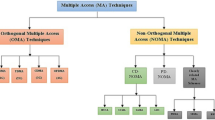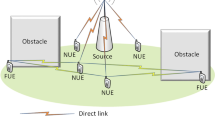Abstract
Non-orthogonal multiple access (NOMA) is a prominent 5G wireless communication technique which ensures higher spectral efficiency, low latency and user fairness. As power-domain NOMA exploits different power levels assigned to each user for decoding, therefore, performance of this scheme degrades badly in a network having approximately equidistant users. To address this challenge, a novel hybrid CDMA–NOMA scheme for 5G downlink is proposed in this paper. Superposition coding is done at the transmitter side while successive interference cancellation (SIC) is performed at the receiver. The proposed scheme differentiates inter-cluster users on the basis of spreading codes, whereas intra-cluster users are differentiated on the basis of different power levels. Interference in the system is mitigated through two different techniques, inter-cluster interference through spreading codes (PN and Walsh codes) while intra-cluster interference through SIC technique. We implement an accurate power allocation strategy with users clustering best with poor model (users with nearest and farthest distances to BS) which is based on the distance of each user from base station. Considering user’s distance and channel coefficient, the proposed technique adapts intelligently among NOMA and hybrid CDMA–NOMA. BER performance of the hybrid CDMA–NOMA system is analyzed in NYUSIM channel model. The proposed approach improves the capacity without increasing the bandwidth and/or number of antennas, and results in reduced interference in congested NOMA systems.













Similar content being viewed by others
References
Andrews, J. G., Buzzi, S., Choi, W., Hanly, S. V., Lozano, A., Soong, A. C. K., et al. (2014). What will 5G be? IEEE Journal on Selected Areas in Communications, 32, 1065–1082.
Ray, P. P. (2015). Towards an internet of things based architectural framework for defence. In 2015 international conference on control, instrumentation, communication and computational technologies (ICCICCT), pp. 411–416.
Wunder, G., Jung, P., Kasparick, M., Wild, T., Schaich, F., Chen, Y., Ten Brink, S., Gaspar, I., Michailow, N., Festag, A., & Mendes L. (2014). 5GNOW: Non-orthogonal, asynchronous waveforms for future mobile applications. IEEE Communications Magazine, 52, 97–105.
Liaqat, M., Noordin, K. A., Latef, T. A., & Dimyati, K. (2018). Power-domain non orthogonal multiple access (PD-NOMA) in cooperative networks: An overview. Wireless Networks, 26, 181–203.
Islam, S. M. R., Avazov, N., Dobre, O. A., & Kwak, K.-S. (2016). Power-domain non-orthogonal multiple access (NOMA) in 5G systems: Potentials and challenges. IEEE Communications Surveys & Tutorials, 19, 721–742.
Pathan, F., & Shringare, K. (2019). Analysis of 5G mobile technologies and DDOS defense. International Research Journal of Engineering and Technology, 6(6), 2973–2979.
Saito, Y., Kishiyama, Y., Benjebbour, A., Nakamura, T., Li, A., & Higuchi, K. (2013). Non-orthogonal multiple access (NOMA) for cellular future radio access. In 2013 IEEE 77th vehicular technology conference (VTC Spring), pp. 1–5.
Islam, S. M., Zeng, M., & Dobre, O. A .(2017). NOMA in 5G systems: Exciting possibilities for enhancing spectral efficiency. arXiv:1706.08215.
Timotheou, S., & Krikidis, I. (2015). Fairness for non-orthogonal multiple access in 5G systems. IEEE Signal Processing Letters, 22, 1647–1651.
Kim, H., Kim, K., Han, Y., & Yun, S. (2004). A proportional fair scheduling for multicarrier transmission systems. In IEEE 60th vehicular technology conference, 2004. VTC2004-Fall (Vol. 1, pp. 409–413).
Otao, N., Kishiyama, Y., & Higuchi, K. (2012). Performance of non-orthogonal access with SIC in cellular downlink using proportional fair-based resource allocation. In 2012 international symposium on wireless communication systems (ISWCS), pp. 476–480.
Sadia, H., Zeeshan, M., & Sheikh, S. A. (2018). Performance analysis of downlink power domain NOMA under fading channels. In 2018 ELEKTRO, pp. 1–6.
Mahmood, A., & Zeeshan, M. (2019). Power allocation and performance analysis of multiuser NOMA under NYUSIM channel model. In 2019 14th conference on industrial and information systems (ICIIS), pp. 296–301.
Benjebbovu, A., Li, A., Saito, Y., Kishiyama, Y., Harada, A., & Nakamura, T. (2013). System-level performance of downlink NOMA for future LTE enhancements. In 2013 IEEE Globecom workshops (GC Wkshps), pp. 66–70.
Larsson, E. G., Edfors, O., Tufvesson, F., & Marzetta, T. L. (2014). Massive MIMO for next generation wireless systems. IEEE Communications Magazine, 52, 186–195.
Rihan, M., Huang, L., & Zhang, P. (2018). Joint interference alignment and power allocation for NOMA-based multi-user MIMO systems. EURASIP Journal on Wireless Communications and Networking, 2018, 1–13.
Ali, S., Hossain, E., & Kim, D. I. (2016). Non-orthogonal multiple access (NOMA) for downlink multiuser MIMO systems: User clustering, beamforming, and power allocation. IEEE Access, 5, 565–577.
Liu, S., Zhang, C., & Lyu, G. (2015). User selection and power schedule for downlink non-orthogonal multiple access (NOMA) system. In 2015 IEEE international conference on communication workshop (ICCW), pp. 2561–2565.
Kim, J., Koh, J., Kang, J., Lee, K., & Kang, J. (2015). Design of user clustering and precoding for downlink non-orthogonal multiple access (NOMA). In MILCOM 2015-2015 IEEE military communications conference, pp. 1170–1175.
Ali, M. S., Tabassum, H., & Hossain, E. (2016). Dynamic user clustering and power allocation for uplink and downlink non-orthogonal multiple access (NOMA) systems. IEEE Access, 4, 6325–6343.
Mohammadkarimi, M., Raza, M. A., & Dobre, O. (2018). A Signature-based nonorthogonal massive multiple access for future wireless networks: Uplink massive connectivity for machine-type communications. IEEE Vehicular Technology Magazine, 13(4), 40–50.
Amini, M. R., & Baidas, M. W. (2020). Random-access NOMA in URLL energy-harvesting IoT networks with short packet and diversity transmissions. IEEE Access, 8, 220734–220754.
Abbas, R., Shirvanimoghaddam, M., Li, Y., & Vucetic, B. (2018). A novel analytical framework for massive grant-free NOMA. IEEE Transactions on Communications, 67(3), 2436–2449.
Rappaport, T. S., MacCartney, G. R., Samimi, M. K., & Sun, S. (2015). Wideband millimeter-wave propagation measurements and channel models for future wireless communication system design. IEEE Transactions on Communications, 63, 3029–3056.
Samimi, M. K., & Rappaport, T. S. (2016). 3-D millimeter-wave statistical channel model for 5G wireless system design. IEEE Transactions on Microwave Theory and Techniques, 64, 2207–2225.
Ju, S., & Rappaport, T. S. (2018). Simulating Motion-incorporating spatial consistency into NYUSIM channel model. In 2018 IEEE 88th vehicular technology conference (VTC-Fall), pp. 1–6.
Zeeshan, M., Khan, S. A., & Malik, M. Y. (2013). A secure DS-CDMA technique with capacity enhancement for ad hoc wireless networks. IT Convergence and Security, 2012, 159–167.
Author information
Authors and Affiliations
Corresponding author
Additional information
Publisher's Note
Springer Nature remains neutral with regard to jurisdictional claims in published maps and institutional affiliations.
Rights and permissions
About this article
Cite this article
Mahmood, A., Zeeshan, M. & Ashraf, T. A new hybrid CDMA–NOMA scheme with power allocation and user clustering for capacity improvement. Telecommun Syst 78, 225–237 (2021). https://doi.org/10.1007/s11235-021-00805-x
Accepted:
Published:
Issue Date:
DOI: https://doi.org/10.1007/s11235-021-00805-x




